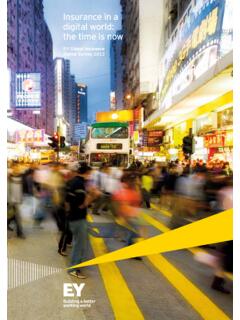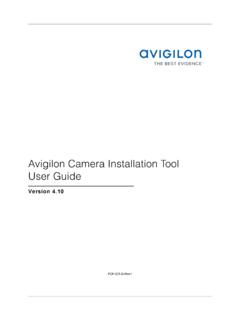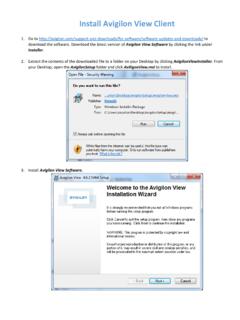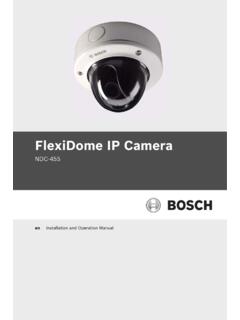Transcription of ExEcutivE briEfing: undErutilizing SEcurity - Forbes
1 ExEcutivE briefing : undErutilizing SEcurityin aSSociation with:1 Green, Mary W. (1999) The Appropriate and Effective Use of SEcurity Technologies in Schools, A Guide for Schools and Law Enforcement Agencies, Sandia National LaboratoriesIntroductIonAs part of a larger set of research being undertaken by avigilon and Forbes , we set out to determine how businesses are current-ly using video surveillance and analytics. The following briefing outlines our findings on levels of asset coverage by surveillance and utilization of active monitoring, as well as how long the data is stored and what uses it s put to after being recorded.
2 At its most basic, video surveillance is an effective tool for SEcurity of assets and facilities, but its potential extends far past SEcurity and into bottom line business objectives. Typical secu-rity setups may involve hundreds of cameras, on-site SEcurity guards or personnel employed to monitor live video feeds from one or several cameras at once. The drawback of these methods is that they can be both expensive and ineffective. Research has found the effectiveness of human video surveillance monitoring to rapidly decline: in one study guards missed up to 95% of all activity after just 20 it is perhaps unsurprising that our research finds businesses significantly underutilize their video surveillance and analytics even for basic SEcurity , and seem to be largely unaware of its applications beyond that.
3 However, advances in camera technology and the analytics underpinning them means that the costs (a major concern identified in our research) have come down significantly, while the applications have expanded. For one thing, today s multi- megapixel high-resolution cameras can cover greater areas with fewer cameras overall, meaning a reduction in attendant costs. Every time you eliminate a camera, you re saving on software, cabling and installation , says Alexander Fernandes, avigilon s Founder, President, Chief ExEcutivE Officer and Chairman of the video analytics-aided monitoring can address effectiveness concerns by alerting SEcurity personnel only to legitimate activity of interest.
4 Video analytics is the key to making action-able video, says Fernandes. It filters out all the noise and gets straight to the point of interest. It s massively powerful. At the same time, respondents seem largely unaware of the potential of the huge repository of data they already own in their stored video footage. Our research suggests that once re-corded, footage is rarely reviewed except in the case of an inci dent. Not only are businesses storing large amounts of data for lengthy periods of time, at what can be assumed is a non-trivial cost, but they are often failing to make use it of it beyond post-incident forensic review.
5 In a big data-dependent business environment, these organizations are missing valuable opportuni-ties to make this data earn its keep in other parts of the business. Essentially, video surveillance is one of the biggest sources of information about the world around us, and it has not yet been tapped into, says Fernandes. There s a whole new era of possibilities in proactively mining this data, and that starts with video analytics. undErutilizing SurvEILLancE 58% say their organizations cover 50% or less of their valuable assets with video surveillance.
6 The trend is more significant in the healthcare and critical infrastructure (oil, gas, utilities and energy) industries: 72% and 71% of respondents, respectively, estimated that less than half their valuable assets are covered by video surveillance. Just 4% of respondents report 100% of their valuable assets are currently covered by video surveillance. Where video surveillance is in use, two-thirds of respondents (66%) estimate less than half the footage is actively monitored by SEcurity personnel.
7 Again, the trend is more significant in certain industries; in healthcare (81%), transportation and logistics (74%), and critical infrastructure (68%) in particular. The proportion of respondents who indicate SEcurity personnel actively monitor at least 75% of all surveillance was again low just 20% overall and only 9% reported 100% monitoring. obStacLES to uptakE Cost-effectiveness (52%), effectiveness of monitoring (29%) and the nuisance of false alarms (21%) were the three factors most often cited as preventing further investment in video surveillance monitoring.
8 2 | ExEcutivE briefing : undErutilizing SEcurityour rESEarch IndIcatES that many buSInESSES arE LaGGInG In both SurvEILLancE and actIvE monItorInG. thE majorIty arE rEcordInG or monItorInG LESS than 50% of thEIr aSSEtS and footaGE. doES that fIt wIth your own obSErvatIonS?That is right in line. If you ve just got video covering an area where assets are kept, but nobody is monitoring that video in some capacity, then you re not protecting the asset, you re just recording whatever happens to the arE thE conSEquEncES for buSInESSES that don t EnGaGE In actIvE monItorInG?
9 Ultimately, you re not getting the most from your video surveillance investment. It s great to have really nice cameras and wonderful playback quality, but if you have a business with outdoor inventory, and it gets stolen or damaged at 3 Saturday morning, and you don t realize it until you get in on Monday morning, then you have to sift through footage to try and figure out what happened. Once you discover that: do you have enough evidence to identify, apprehend and prosecute, or recover property? Most cases you re not going to.
10 You re just going to have great images of somebody steal-ing or damaging your assets. coSt pLayS a bIG part In thE dEcISIonS of buSInESSES not to InvESt morE In actIvE monItorInG IS that concErn foundEd? If they re thinking of active video monitoring as having to pay a person to watch live video that s going to be very expensive. If you have to do that around the clock, you re going to spend over $100,000 a year on that; that s definitely a cost concern. If you add video analytics, using the right kind of technology, the right smart algorithms, being able to set the right rules for the conditions that you want to be notified on and then either remotely monitor or self-monitor you re able to do it at a much more effective rate.

















